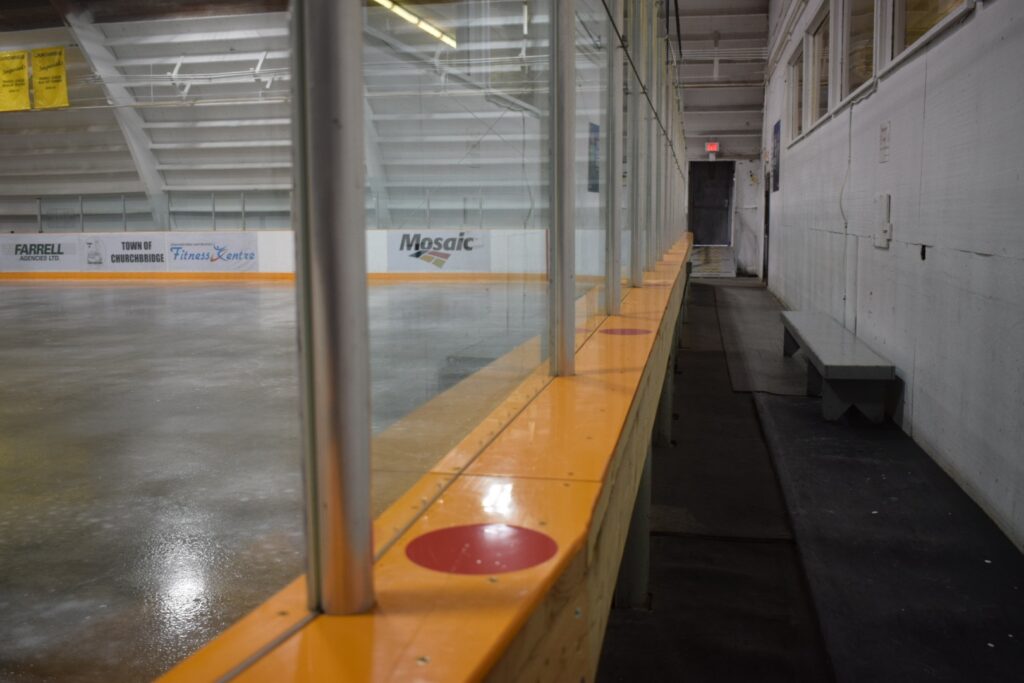Kids and adults alike will have the chance to lace up their skates again this season. The Saskatchewan Hockey Association (SHA) recently provided some added guidance on what that return to hockey plan will look like.
The Kaminski Arena in Churchbridge is ready for athletes and their families to embrace the winter tradition of hitting the ice for some hockey or to go figure skating. Months of effort went into planning how the facility could be opened in the safest and most comfortable manner.
Immediately upon entering the community arena in Churchbridge, visitors will notice signs displaying the protocol that the Kaminski arena board put forth. A quick stroll up the stairs to the main lobby will take you to the next safety measure put into place; a sign-in book and a display sign showing that masks are mandatory in the rink. There are pencils provided for the sign-in book, but if patrons have their own writing utensil they can use them. There are masks available if visitors do not have their own, although many people have their own already which they may bring.
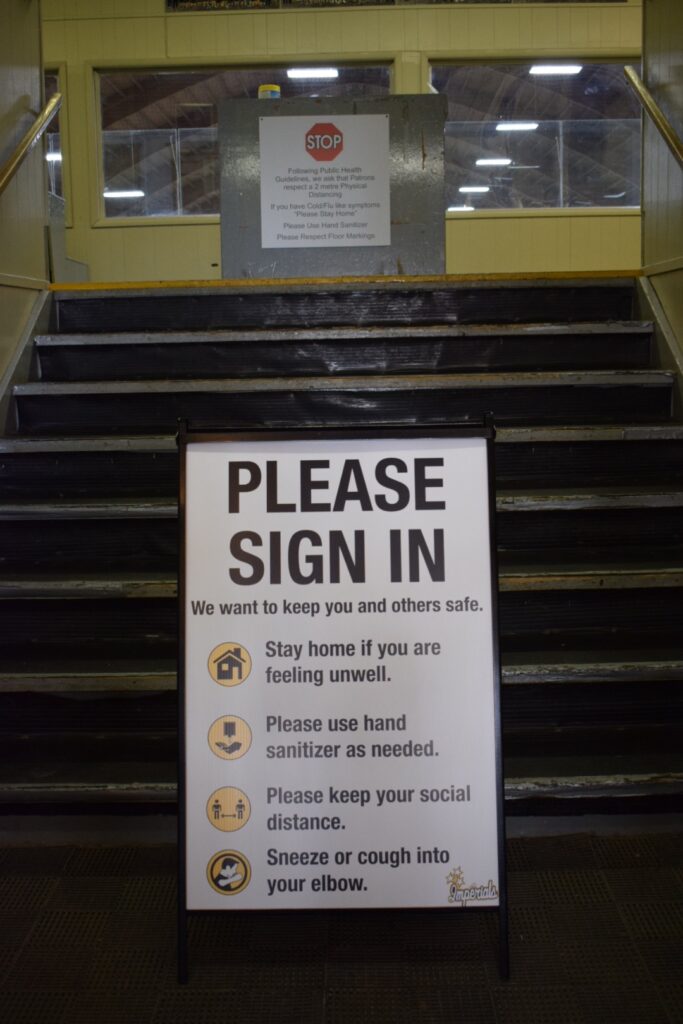
Follow the path a bit further and you will be greeted by walking direction arrows that seem standard now-a-days in many high-traffic walking locations. The bleachers have decals which patrons can sit on to ensure they are keeping their adequate distance from others that the provincial health authority expects.
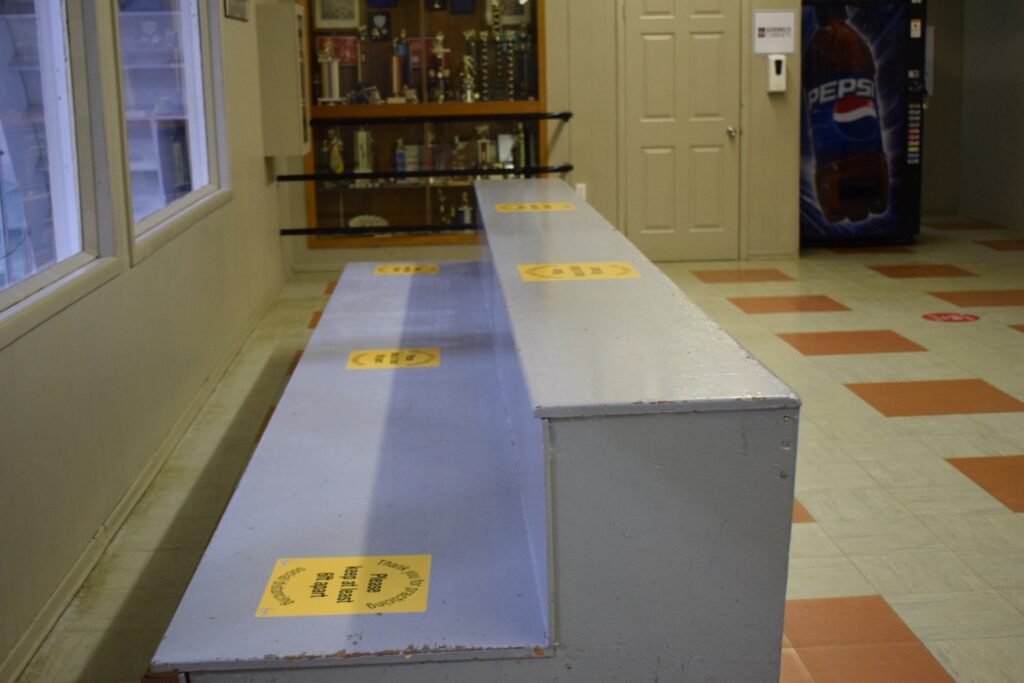
For all practices, one parent or designate is allowed in with their child. For games, the family can come on out to support their athlete and cheer in the stands. There are decals on the majority of bleachers that fans can sit on to ensure the spacing the Saskatchewan Health Authority recommends.
Visitors will see signage and hand sanitizing stations all around the arena to keep visitors aware of the safety measures; the Kaminski Arena Board feels that safety is a priority and they want to keep the rink open this season. Carter Prier, member of the Kaminski Arena Board, said, “We’ve tried to cover every angle. As a board, we know there might be a few people who break the rules. We’ll explain things to them if it happens, but if we see it’s continually happening day in and day out the arena board can decide to close the arena. Please remember it took months of planning and work to get us here.”
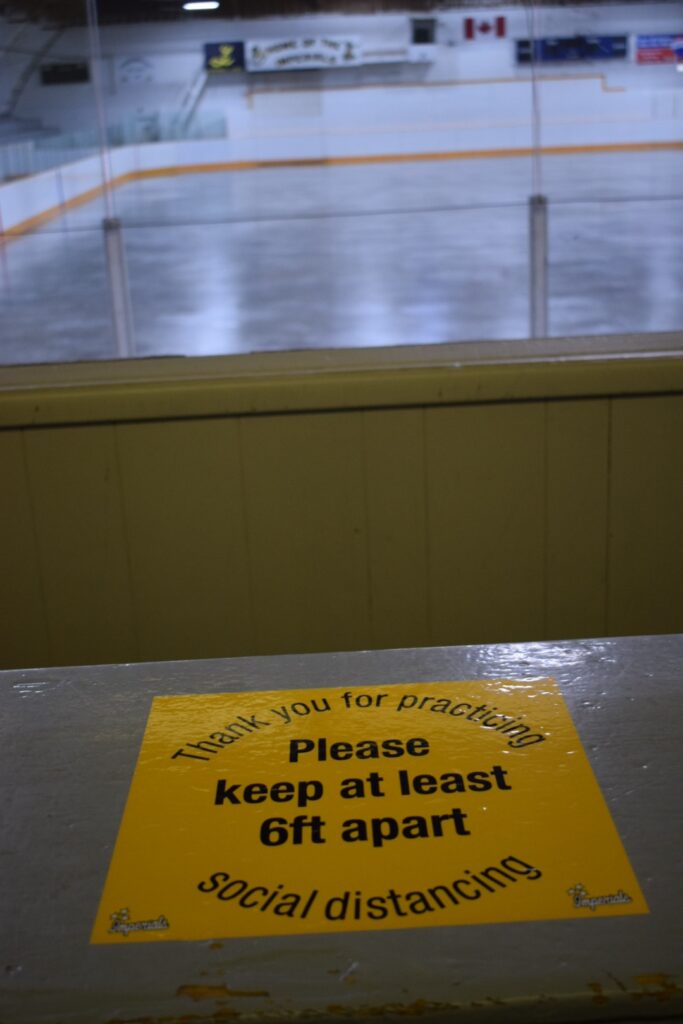
The arena board aimed to create an environment that had “the least possible amount of transmission chances” although they understand public commitment to the plan is vital to the arena’s success.
With teams travelling from one community to another for games, there is an increased risk in transmitting any illnesses. The arena committee wanted to have the arena open for the season and stepped up to the plate to ensure visitors feel comfortable and welcomed when coming through the front doors. The goal is not to simply have the rink open, the intent is to also ensure kids, parents and grandparents feel their safety is a priority upon arrival.
“For the amount of people that are going to be coming in, and the measures put in place, it’s going to be a really safe place,” said Prier.
There will be hockey practices and games, public skating, figure skating and public bookings happening like any other year; the difference will be the safety measures put into place to ensure the rink does not become the latest place for an illness outbreak.
Carter explained, “When people first come in they will see the signs. People from town will get used to it right off the hop. As hockey games start and different events happen, people from out of town will come in and they’ll read right away that masks are mandatory and see the friendly reminders.”
The Saskatchewan Hockey Association said masks are mandatory for hockey games. The arena board kept this protocol to be standard for all their rental groups; figure skating included. Masks are not mandatory for players while they are on the ice; coaches and visitors in the stands will be required to wear one.
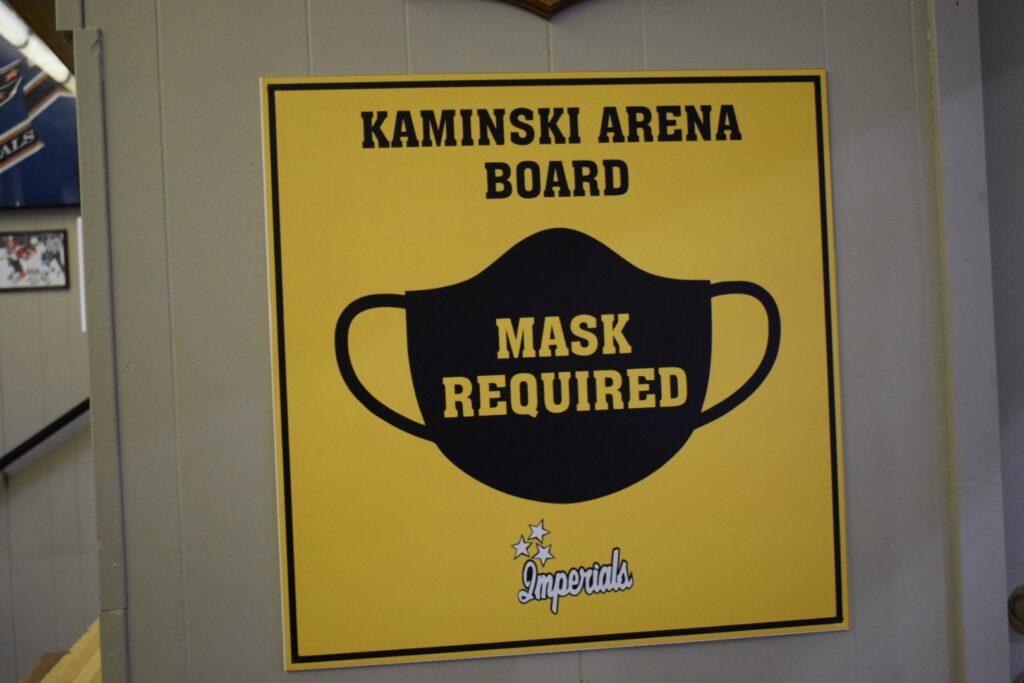
Speaking about the interest from booking groups, Carter said, “We’ve got all of our minor sports teams involved this year (three teams in town for minor hockey), as well as two rec teams and lots of interest from third-party rentals for private skating and camps. If anything, we’re going to have the same number of groups as last year, if not busier this year.”
The expectations are the same for all groups using the rink. Whatever the decided maximum capacity is for seating will be universal across the board. There can only be thirty people on the ice at a time, as of now. If someone wanted to sponsor a group skating event it would be possible, although skaters would need to be mindful of the maximum number of skaters allowed on the ice at one time; masks are not required for those skating on the ice and helmets are to be worn.
There are five hand sanitizing dispensers located around the arena, so there is no shortage of the product for the public.
There are proactive health measures put in place and things will look different, the important part is the community and other groups can still use the venue. Carter said, “It will be a heck-of-a-lot different, but as long as everyone is good with the rules and respects all the signage and the other people, that’s the main thing.”
Thankfully, the cost of the COVID-19 prevention equipment is covered by a Restart Canada Plan grant. Saskatchewan was given $70 million which was divided amongst the municipalities on a per-capita basis. The money helped cover the sanitizer, decals, sneeze guards and other prevention measures put in place.
There will be a designated locker room (or two for larger squads) that each team will use for the season. The players are expected to show up fully dressed, except for skates and a helmet. Prier explained, “You show up fifteen minutes before, go down, tie your skates, put your helmet on; while that’s happening you still have your mask on until your helmet goes on.” Every dressing room has dots on the wall that players can sit in front of to help them keep a healthy distance. The washrooms in the changerooms will be open, but the showers won’t be. If the players want to undress in the locker room, they have fifteen minutes to get out of their sweaty equipment before they head home.
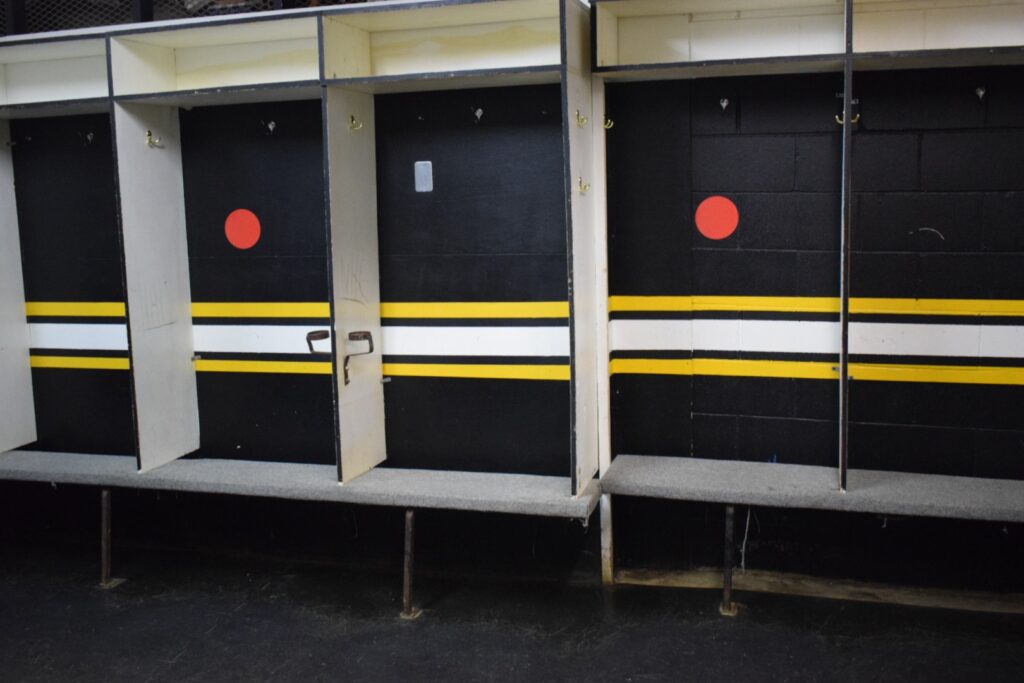
The rink kitchen has sneeze-guard plexi-glass barriers put in place to prevent transmission from kitchen workers to customers. The kitchen will be run by a rotating group of parents of the athletes. There will be a limited menu, but the classic food that comes to mind as ‘rink food’ will still be available; fries, chicken fingers and ribs are a few of the items that spectators will be able to enjoy. Prier said, “It’s going to be like it was decades-ago; just parent volunteers.” There is something to be said for the tremendous service previous tendered groups provided, but the parents will be up to the task to keep the deep frier going this year.

Normally, a lot of different groups would rent the Blue Room upstairs for gatherings, but the room is not opening this year. A lot of the larger arenas have employees hired to help keep their rinks fully functioning; our local volunteer group organizing the rink is focusing on their priorities of safety and the athletes with their limited volunteer resources.
Toni and Carter Prier will find themselves doing much of the sanitizing between the group rentals. Carter mentioned that there is a thirty minute stagger in the schedule between when one group finishes and the next arrives. Prier added, “It’s going to be busy, but we are set up well.” The main doors will be used for entering and exiting as no groups will be crossing paths, if the group finds this happening they will adjust the times between bookings. Rentals are spaced to not overlap times, and teams are booked so that the crew coming into the rink heads to the opposite side of the arena to change compared to the team currently on the ice.
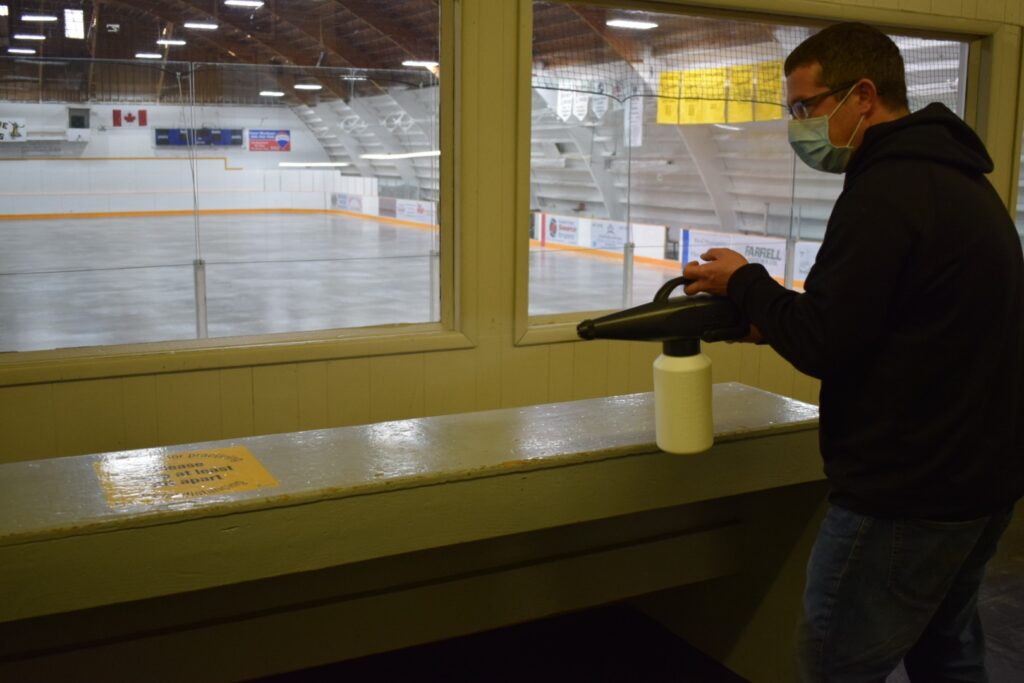
The volunteers can use a nifty fogging device to sanitize the high-touch areas in-between bookings. Carter did a test on the chemical reaction with clothes, to ensure that it does not cause discolouration on personal items. He sprayed the benches, placed clothing and equipment on a bench with a weight placed on them. The next day the clothes were still in perfect condition. Carter took two weeks off on vacation from work to get everything going and to get the ice put in. He had some vacation time at work that he had to use, and the arena was calling his name; this is the kind of support that directly benefits the community and will keep our youth involved and on the ice this season. He assured rink users, “For a large building used by many people from different towns, I feel the steps we’ve taken and the rules we’ve come up with, everyone will be comfortable and confident they can come in and watch their kid or grandkid play; they can still enjoy their time and feel safe. We will explain things and I’m very confident everyone will adapt really well to the new rules.”
COVID has affected the way the Kaminski Arena operates, besides the new health rules it affected the cash supply, as with all other non-profits in the town and area.
The arena lost out on approximate $15 000 due to other cancelled community fundraisers; this money ensures that our lights are on and doors are opened. The town covers insurance, and a large portion of the ice tender contract; the arena board covers everything else through user fees, fundraisers, private donations, business donations and grants.
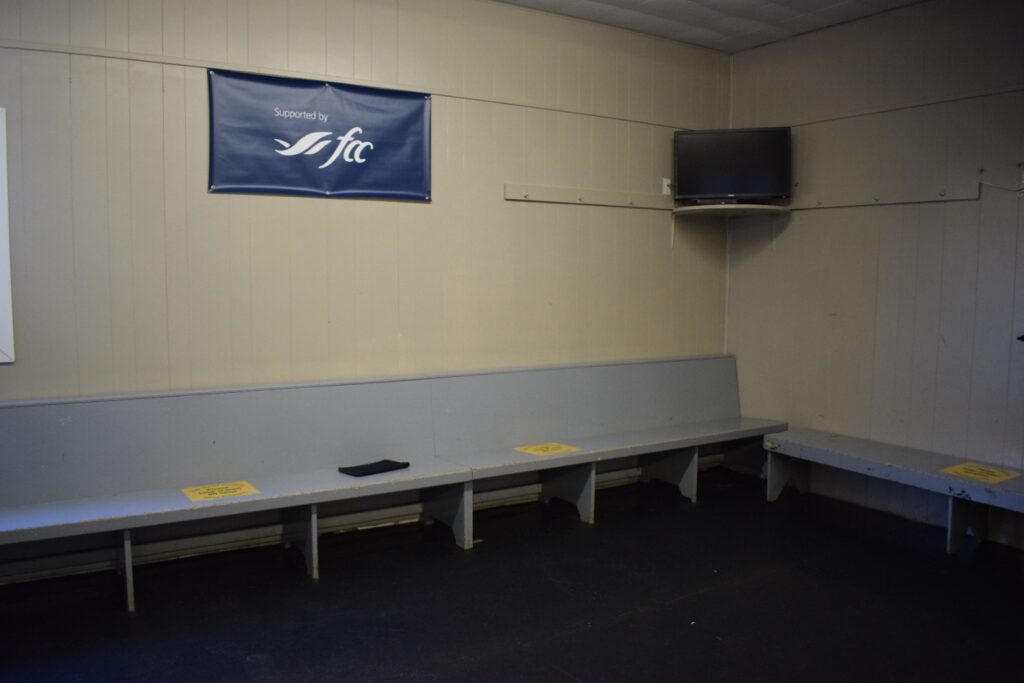
Prier added, “As a board we are going to have to get creative in our fundraising, getting together with 100 people isn’t going to happen this year, and who knows, maybe things won’t even be operating next season.”
Other means of fundraising for the arena board include a Facebook auction being planned for November 23-25, a cash raffle with a draw date of December 23rd and a pork raffle (tickets will be out after Christmas, draw date will be late May).
